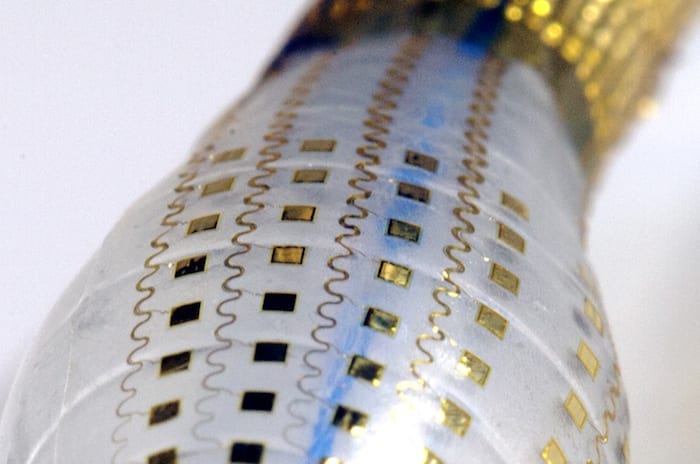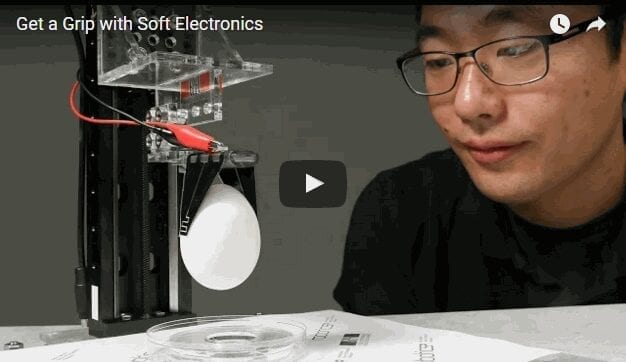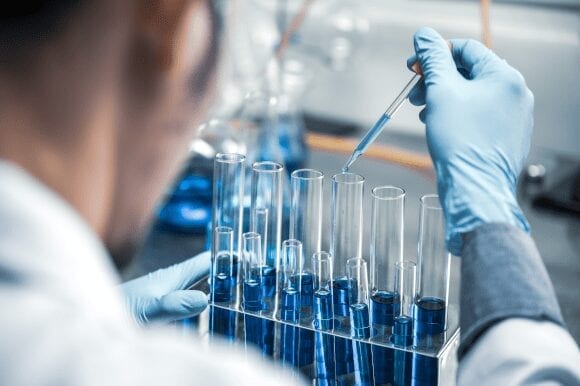
A conformal array of electrodes affixed to an inflated balloon catheter
A new class of medical instruments equipped with a soft electronics system improves diagnostic and therapeutic interventions in minimally invasive surgeries
Researchers developed a new class of medical instruments equipped with an advanced soft electronics system that could dramatically improve the diagnoses and treatments of a number of cardiac diseases and conditions.
Detailed in a new paper published in the journal Nature Biomedical Engineering, the researchers, led by engineers at the George Washington University and Northwestern University, applied stretchable and flexible matrices of electrode sensors and actuators, along with temperature and pressure sensors, to a balloon catheter system, often used in minimally invasive surgeries or ablations to treat conditions such as heart arrhythmias.
The new system, which conforms better to the body’s soft tissue than current devices, can perform a variety of functions, including: simultaneous in vivo measurements of temperature, force of contact and electrophysiological parameters; the ability to customize diagnostic and therapeutic functions; and real-time feedback. The new system can also dramatically reduce the length of invasive ablation procedures and exposure of patients and doctors to X-ray radiation.
THE SITUATION
Many minimally invasive surgeries rely on catheters inserted into the body through small incisions to conduct diagnostic measurements and therapeutic interventions. Physicians, for example, use this catheter-based approach to map and treat irregular heartbeats, or arrhythmias, often by locating and killing or ablating cardiac tissue area which is causing the arrhythmias.
Though widely used in surgery, the current catheter-based approach has a number of drawbacks. The rigidity of today’s catheter devices means they do not conform well to soft, biological tissues, impacting high fidelity mapping of an organ’s electrophysiological signals. Current devices make contact with only a small part of an organ at a time, making it necessary to constantly move a probe around, lengthening medical procedures. Current catheter systems are also limited in the number of functions they can perform, requiring physicians to use multiple catheters in a single ablation procedure.
Additionally, long procedures—for example, to locate and ablate tissues causing arrhythmias—risk exposing both patient and physician to potentially damaging X-rays, as physicians rely on X-ray images during the course of the surgery to guide their catheters.
THE BENEFIT
The new class of instruments the researchers developed will allow physicians to acquire a rich set of electrophysiological information and to complete surgeries in shorter times with a single instrumented catheter system.
By outfitting a balloon catheter with advanced organ conformal electronic components, sensors and actuators, the researchers overcame the flaws of current systems. Specific advances over previous systems include:
- Instrumented sensors and actuators in multiplexed array formats can probe the complex nature of tissues, specifically in the beating heart. This will allow, for example, for better localization of sources of lethal arrhythmias causing sudden cardiac death.
- The device’s multilayered and multifunctional architecture with combined diagnostic and therapeutic functions enhances a number of minimally invasive cardiac procedures, including radio frequency or irreversible electroporation ablation—wherein cardiac or nerve cells are ablated, or “burned,” to eliminate sources of arrhythmia—and the delivery of drugs and other biomaterials directly into cells through a process called reversible electroporation.
- Capabilities for real-time feedback control, enabled by simultaneous, multimodal operation of sensors and actuators.
FROM THE RESEARCHERS
“We have taken new breakthrough materials and fabrication techniques typically employed by the semiconductor industry and applied them to the medical field, in this case cardiology, to advance a new class of medical instruments that will improve cardiac outcomes for patients and allow physicians to deliver better, safer and more patient-specific care.”
– Igor Efimov, the Alisann and Terry Collins Professor of Biomedical Engineering at the George Washington University
“Hard, rigid catheters cannot conform to the heart because the heart itself is not hard and rigid. We leveraged our advances in soft, stretchable and flexible electronics to develop medical devices that include elastic, interconnected arrays of sensors and actuators, capable of gently and softly conforming to tissue surfaces. The result improves the accuracy and precision of associated surgical processes, for faster, less risky and more effective treatments.”
– John A. Rogers, the Louis A. Simpson and Kimberly Querrey Professor of Materials Science and Engineering, Biomedical Engineering and Neurological Surgery at Northwestern University
The Latest Updates from Bing News & Google News
Go deeper with Bing News on:
Smart sensor surgical tools
- Fighting cancer at the root
Researchers at the branch of the German Cancer Research Center (DKFZ) in Dresden are working on tiny robots. These are designed to act ...
- Wearables and the Surgical Revolution
This article explores the transformative impact of wearable technology on surgical procedures, from pre-operative optimization to post-operative recovery. It delves into recent advancements such as ...
- Best Smart Lights for 2024
A CNET editor since 2013, Ry's beats include smart home tech, lighting, appliances, broadband and home networking. Chris Wedel is a fan of all things tech and gadgets. Living in rural Kansas with ...
- Smart Sensor Market CAGR of 14.30%, Unlocking Growth Opportunities Insights from a Size Explorer
Smart Sensor Market was valued at $ 37.12 billion in 2019 ... We utilize the most recent technology and analysis tools along with our own unique research models and years of expertise, which assist us ...
- The best smart home devices in 2024
Whether you're looking to turn your lights on from your smartphone, stream music to a smart speaker using Alexa (or Google Assistant), lock your doors remotely or automatically vacuum your floors ...
Go deeper with Google Headlines on:
Smart sensor surgical tools
[google_news title=”” keyword=”smart sensor surgical tools” num_posts=”5″ blurb_length=”0″ show_thumb=”left”]
Go deeper with Bing News on:
Smart catheter
- Biosense Webster Launches New Version of CARTO™ 3 Electro-Anatomical Mapping System
Biosense Webster, Inc., a global leader in cardiac arrhythmia treatment and part of Johnson & Johnson MedTech, announces the launch of CARTO™ 3 System Version 8, the latest version of the company's ...
- NSE Alpha Scoring Balloon Catheter from B. Braun
The Scoring Balloon Catheter NSE Alpha is designed for precise dilatation across a wide range of lesion types. NSE Alpha has three scoring elements for a controlled scoring of the vessel wall and ...
- Medtronic has more positive transcatheter heart valve data
Medtronic (NYSE: MDT) today announced the release of new data for its transcatheter heart valve therapy technologies.
- Introducing the smart catheter for the heart
Joshua M. Cooper inserted a catheter through a vein in Janice McKemey’s groin, up through her abdomen and all the way inside her heart.
- Why Are Younger Adults Developing This Common Heart Condition?
New research suggests that A-fib may be more prevalent, and more dangerous, in people under 65 than previously thought.
Go deeper with Google Headlines on:
Smart catheter
[google_news title=”” keyword=”smart catheter” num_posts=”5″ blurb_length=”0″ show_thumb=”left”]










